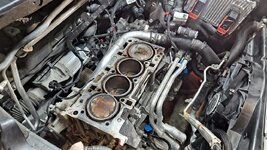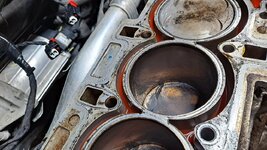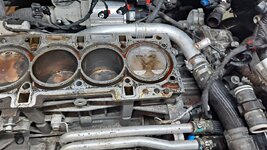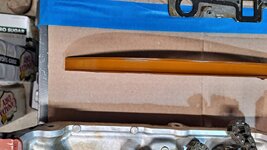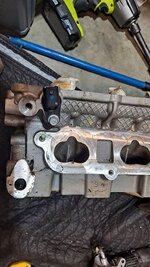Hello Everyone,
My Dodge Dart started using coolant about a month ago. I suspected that the head gasket was leaking since I could not find any external leaks. A combustion coolant tester confirmed my suspicions. I have attached some photos for you all to review. I have 2 sets of photos that I will post.
Needless to say the engine is really clean on the inside. I acquired this car with about 60k on the clock. It has the 2.0 litre Tigershark engine. The CARFAX at the time indicated that the car had regular oil changes and I have followed the same service intervals of changes every 5 - 6k. The car now has 82k.
I am really surprised by the evidence of hardly any wear whatsoever in the cylinder bores. There is no ridge line and the bores are really clean.
I plan to replace all of the usual wear and tear items while it is apart (timing chain, and guides, water pump, serpentine belt, idler and tensioner pulleys etc).
Since I have owned the car the oil used has been Mobil 1 full synthetic 0w20. Filters have varied, from Mobil 1, and Purolator brands. Head will be eventually cleaned and decked before reassembly. The cam lobs and bearing journals are all in excellent shape.
I wanted to share these details with you all in the hopes of reassuring what many of us who do regular maintenance on our vehicles already know. That is, that today's synthetic oils do a wonderful job when it comes to wear protection, and keeping engines clean internally.
Please reply with any comments or questions. I will be happy to reply to all who may want to know more detail.
My Dodge Dart started using coolant about a month ago. I suspected that the head gasket was leaking since I could not find any external leaks. A combustion coolant tester confirmed my suspicions. I have attached some photos for you all to review. I have 2 sets of photos that I will post.
Needless to say the engine is really clean on the inside. I acquired this car with about 60k on the clock. It has the 2.0 litre Tigershark engine. The CARFAX at the time indicated that the car had regular oil changes and I have followed the same service intervals of changes every 5 - 6k. The car now has 82k.
I am really surprised by the evidence of hardly any wear whatsoever in the cylinder bores. There is no ridge line and the bores are really clean.
I plan to replace all of the usual wear and tear items while it is apart (timing chain, and guides, water pump, serpentine belt, idler and tensioner pulleys etc).
Since I have owned the car the oil used has been Mobil 1 full synthetic 0w20. Filters have varied, from Mobil 1, and Purolator brands. Head will be eventually cleaned and decked before reassembly. The cam lobs and bearing journals are all in excellent shape.
I wanted to share these details with you all in the hopes of reassuring what many of us who do regular maintenance on our vehicles already know. That is, that today's synthetic oils do a wonderful job when it comes to wear protection, and keeping engines clean internally.
Please reply with any comments or questions. I will be happy to reply to all who may want to know more detail.

